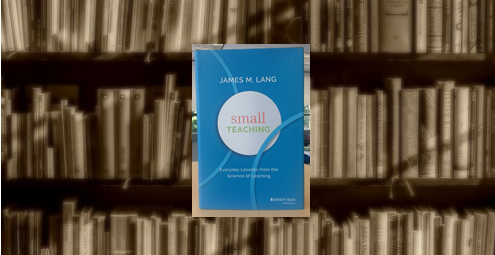Bloom and Knowledge as Foundational
Do you ever feel that the interpretation of Bloom’s taxonomy in the form of a pyramid favours higher order thinking skills like critical thinking or creation of new knowledge over helping students learn and remember facts and concepts? Or do you occasionally wonder about our role as teachers in helping student learn more “basic” knowledge?
Our CTE book club is currently reading the book Small Teaching: Everyday Lessons from the Science of Learning (James M. Lang, 2016). As we discussed Part I of the book recently, we all appreciated the way Lang starts out by discussing the importance of knowledge, and of students developing a rich body of knowledge in our content areas. The argument is that without foundational knowledge and the mental structures to organize such knowledge, students can’t get to the top of the pyramid and engage in creative and critical thinking.
Implications for Instructors
So what are some of the implications of this for instructors? Lang’s key argument is that this knowledge base doesn’t just occur on its own or in high school (or by asking the students to rely on Google outside of class). Essentially, as post-secondary instructors, we need to intentionally help students acquire knowledge and we can do so by applying the theory, principles and small teaching strategies of retrieving, predicting and interleaving.
Small Teaching offers anecdotal as well as evidence based research and models for why we should care about retrieving, predicting and interleaving. Below, we are sharing Lang’s definition of each learning principle as well as some of the Small Teaching strategies suggested in the book:
Retrieving
The retrieval effect (or the testing effect): “if you want to retrieve knowledge from your memory, you have to practice retrieving knowledge from your memory” (p. 20)
Small Teaching Tips for retrieving include:
– Frequent low stakes quizzes o Opening questions reminding students of content previously covered o Closing questions such as the minute paper o Short quiz at the end of class o Use the syllabus to redirect students to previous content – Frequent low stakes quizzes o Opening questions reminding students of content previously covered o Closing questions such as the minute paper o Short quiz at the end of class o Use the syllabus to redirect students to previous content
Predicting
Predicting results (or content) improves memory because it makes us pay closer attention, it hooks our emotions into the game (raises our curiosity), and it prepares our brains for building the needed connections and pathways to make learning stick: “Making predictions about the material you wish to learn increases your ability to understand that material and retrieve it later” (p. 43). It also helps counter the challenge of “fluency illusion” (p. 51).
Small Teaching Tips for predicting include: o Pretests in the beginning of class o Asking students to write down what they already know prior before covering a topic o Stop to ask student to predict outcomes of cases, stories etc. o Let students try a new cognitive skill before they feel ready o Closing questions predicting what’s coming up. Interleaving Interleaving refers to spacing learning over time and mixing the practice of skills you are seeking to develop. By interleaving (rather than blocking) content, we are forced to make choices about which learned skills to apply in which context (assess context and discriminate between problems), which leads to more long term retention and the possibility of mastery of higher order cognitive skills. Small Teaching Tips for interleaving include: o Include “older course content” in small parts of your major exams
- Include “older course content” in small parts of your major exams
- Open and close classes with opportunities to draw on and apply older knowledge and skills
- Create mini review sessions
- Use quizzes and exams to connect older and new material and revise understanding
- Stagger deadlines and quizzes
As you ponder how these principles and strategies apply – or could apply – to your context, classes and teaching (and perhaps to less test based classes too), you may feel reassured by the fact that the depiction of Blooom’s taxonomy as a pyramid in fact recognizes that students cannot get to the top without a solid knowledge foundation beneath them. And that you play an essential role in making this happen:
“One of our first and most important tasks as teachers is to help; students develop a rich body of knowledge in our content areas – without doing so, we handicap considerably their ability to engage in cognitive activities like thinking and evaluating and creating” (Lang, 2016, p. 15)

Recent Comments